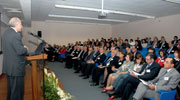Gilbert and Rose-Marie Chagoury School of Medicine Opens Its Doors

In September 2009, the Gilbert and Rose-Marie Chagoury School of Medicine admitted its first class of students.
According to President Jabbra, the school aims to produce doctors who “are energized by a fundamental ethical fiber that would govern their behavior day in and day out.”
LAU board member Gilbert Chagoury, St. Lucia’s ambassador, permanent delegate to UNE SCO, and ambassador to the Holy See, and his wife, Rose-Marie, provided a donation of $10 million to fund the medical school and $3.5 million for the construction of the Alice Ramez Chagoury School of Nursing.
The $18 million complex is a technologically advanced, 12,500-square-meter structure designed to house the school’s innovative curriculum. An affiliation with Harvard Medical International (HMI ) was established in 2007 as part of a 10-year collaborative effort in which representatives are consulted on issues such as curriculum development, faculty standards, and admissions processes. HMI delegates Dr. Lynn Eckhert, director of academic programs; Dr. Thomas Aretz, vice president, global programs; and Dr. Constance Bowe, senior consultant, spent four days in May with faculty and administrators at an annual Joint Advisory Board meeting and a faculty development workshop at Le Meridian Commodore Hotel in Beirut.
“LAU is a special institution that really knew what it wanted to accomplish. It decided it wanted high quality and excellence in education. [The representatives] are very experienced, know what they want, and are willing to work together,” Dr. Eckhert said. Dr. Aretz agreed: “I think [LAU ] has a track record. It’s really an established institution. It put several new programs and facilities in place. We thought everything was absolutely right.” Dr. Kamal Badr, dean of the School of Medicine (SOM), said the representatives were extremely positive in the evaluation of the school’s progress. “I think they were very impressed. They will be coming and spending extended periods of time here after the school opens, and we look forward to working with HMI in developing our clinical programs,” he added. In April 2009, the SOM held its first founding faculty meeting on the Beirut campus. “The meeting represents a foundational event to help us start the process of building the school,” Badr said.
The school has recruited 108 researchers and doctors out of 300 applicants for faculty positions. Chosen on the basis of high merit and research accomplishment, the faculty members hail from the United States, Canada, the U.K., Lebanon, and other Arab countries, and bring diverse specializations—general surgery, cardiology, neurology, genetics, oncology, radiology, obstetrics, gynecology, dermatology, and gastroenterology.
The SOM signed its first clinical agreement in July 2007 with Clemenceau Medical Center, an affiliate of Johns Hopkins Medicine International, followed by a second agreement with the Rafik Hariri University Hospital in June 2008. According to Badr, this will “provide LAU with an excellent facility for the training of its students, residents, and fellows. It will allow students to gain experience in inpatient and outpatient treatment and observe directly a variety of medical and surgical cases from the outset of their medical education.” “[The SOM] was conceived and designed to create a new physician, one who is superbly trained in the skills of 21st century medicine but who believes deeply that a physician is, above all, a merciful healer,” Badr said.

